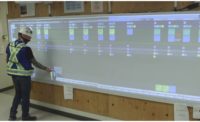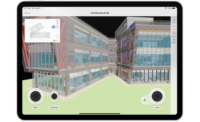Most commonly associated with ensuring proper grading and paving of airport runways and highway projects, 3D control systems often come with a hefty price tag. Faced with the considerable startup costs, many contractors will forgo 3D grade and paving controls unless they are called for in a contract. But a Minnesota-based paving subcontractor found it to be the right solution for the pavement mat beneath the field of the new Vikings Stadium in Minneapolis.
“This was the first time we had ever used a 3D paving system,” says Shawn Bloch, GPS survey manager with Minneapolis-based Park Construction Co., which graded and paved the interior of Vikings Stadium. “It was also the first time it had ever been used in Minnesota, and I think the first time it’s been used to pave the inside of a football stadium.”
Working with 3D controls supplier Sitech, construction manager Mortenson Construction and Caterpillar dealer Ziegler CAT, Park Construction used a Trimble Accugrade PCS900 system to meet the stringent requirements the National Football League has set for new stadium construction. In the spring of 2016, crews set up total stations inside the stadium, and Park Construction’s Caterpillar 160M motor grader and AP1055E paver were equipped with 3D paving and grade control units.
Bloch built a 3D model for each pavement lift as well as for the grading. “First we ran the gravel surface with the motor grader, then we did two lifts of asphalt with the paver to reach a certain elevation,” he says. The machines were governed by the model, relying on the signal from the total station to determine elevations. Crews were taught to use the system in a three-hour session with Sitech.
The NFL’s design standard called for an 1⁄8-in. tolerance for each 10-ft grid segment of the 270-ft by 420-ft asphalt paving area, with no crowns along the edge. But aside from a few low spots on the first lift, the job went smoother than expected, Bloch says. Grading the gravel took three and a half days, and the entire paving process was completed in only two days.
But the real payoff came after the job was done and the inspections began. “We only had two seams on the entire field,” recalls Bloch. When workers for turf installation subcontractor Kiefer USA arrived, their initial reaction was disbelief. “The guy from Kiefer said he had never seen anything this nice, and he didn’t know if he’d even have to use the 10-ft straight edge,” says Bloch. “But the guy from Mortenson said, ‘Go get it.’ Then he grabbed it from the Kiefer truck himself and did it just to show how level it was.” Bloch hopes to use 3D controls on other sports fields and facilities his firm bids on.
Unusual applications for 3D controls are often driven by the contractors’ demands, according to Trimble paving segment manager Kevin Garcia. “One of the biggest recent changes for [3D controls] has nothing to do with the technology providers themselves, but in the way contractors and dealerships are perceiving it,” he says. “As we move into the rental space, contractors with a specific project can see the need for it, and justify the rental cost.”
Examples like Vikings Stadium will become more common as new users try the technology, says Garcia. But the main obstacle for adoption remains awareness. “If you can maximize material usage, you can reduce yields and eliminate rework. Do it right and it lasts longer than traditional methods,” he says.







Post a comment to this article
Report Abusive Comment